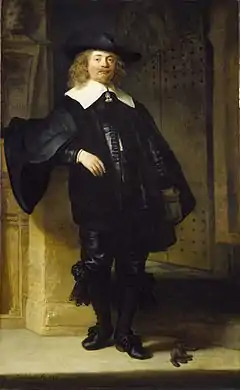Dirk de Graeff van Polsbroek
Dirk de Graeff van Polsbroek (Amsterdam, 28 August 1833 – 27 June 1916, The Hague) was a successful Dutch diplomat in Japan. From July 1863, he held the post of Consul General and Political Agent in Japan. De Graeff became a Diplomat, Generalconsul and Dutch minister in Japan. He was the most important representative of the Dutch government and played a major part in the many negotiations between Japan and various Western countries. De Graeff van Polsbroek was advisor to Emperor Meiji and laid the foundation stone for a modern western (European) diplomacy in Japan.He played also a major part in the many negotiations between various Western countries and Japan.[1][2] He represented Denmark, Sweden and Norway in Japan and temporally Prussia and Switzerland.[3]
Biography

Dirk de Graeff van Polsbroek was born at Amsterdam on 28 August 1833 as a son of Gerrit de Graeff (IV.) Squire of Zuid-Polsbroek, Purmerland and Ilpendam and Carolina Ursulina Stephania Engels. He lived in Japan with his Japanese housekeeper Koyama Ochō with whom he had a son Pieter (Yokohama, 8 June 1861 - 7 August 1914, Bwool (Netherlands Indies). In 1872 he married Bonne Elisabeth Royer. One of his five children was the politician Andries Cornelis Dirk de Graeff who became Netherlands' Ambassador at Tokyo and Governor General of the Netherlands Indies.
When he went to the Dutch Indies in 1853 he added 'van Polsbroek' to his name, probably to discern himself from his brother colonel Gijsbert Carel Rutger Reinier de Graeff in the Colonial Army there. After having worked for the Netherlands Indian government in Batavia, he was appointed on Dejima in June 1857 as assistant 2nd class to the Factory of Dutch Trade. In July 1859, at the time of the opening of the Japanese harbours to trade with foreign countries, he became acting Vice-Consul at Kanagawa. In 1863, when the direction of the Japanese affairs changed from the Ministry of the Colonies to that for Foreign Affairs, he was appointed Consul General and Political Agent. In 1868 he became (titular) Resident Minister of The Netherlands in Japan. He ended his career as a diplomat in 1870 by refusing an appointment in Peking. He was the first western diplomat, who presented his credentials to Emperor Meiji in his new capital Tokyo in February 1869.[4] He was partner in Textor & Co., a trading company established at Dejima in 1858 with his colleague Carl Julius Textor. He was one of the founders of the Yokohama Races (horse racing in Yokohama)[5]
De Graeff negotiated treaties for other European countries with Japan or aided their envoys: Belgium, Denmark, the Hanze cities, Switzerland and Sweden/Norway to mention a few.[6] On leave in The Netherlands in 1870, when he was ordered by the Minister for Foreign Affairs to Peking, De Graeff resigned from his position and became a Commissioner of the Netherlands Trading Society (Nederlandsche Handel-maatschappij)[7] living at The Hague. He was a member of the government commission which received the Iwakura-Mission to The Netherlands in 1873. In the 1870s he received the title of Jonkheer De Graeff and on that occasion he had to drop his self-styled addition to his name 'van Polsbroek'.
Dirk de Graeff died on 27 June 1916 at The Hague.
An Historic Lineage
De Graeff had a very long ancestral lineage, including some of the most prominent persons of the Dutch Republic, such as Andries de Graeff and Cornelis de Graeff, who in 1660 assisted with the provision of the Dutch Gift. The Dutch Gift was a collection of 28 mostly Italian Renaissance paintings and 12 classical sculptures, along with a yacht, the Mary, and furniture, which was presented by the States-General of the Netherlands in 1660 to King Charles II of England upon his restoration to the English throne.[8] A major patron of the arts, Andries de Graeff's full length portrait was created by Rembrandt van Rijn in 1639.

Notes
- Het geheugen van Nederland
- "Bainbridge's Auctions Blog. Dirk de Graeff van Polsbroek". Archived from the original on 2014-03-06. Retrieved 2011-08-10.
- Nederlands adelsboek 1914, p 16
- Painting in the Meiji shrine at Tokyo
- Yokohama Horse Racing Museum
- Documents and letters in the National Archives at The Hague, Foreign Affairs No. 3141-3147; Consular Archives of Nagasaki and Yokohama 1860-1869)
- National Archive The Hague, Archive of the Netherlands Trading Society
- Whittaker and Clayton: pp. 31–2 for the art, Gleissner for the furniture and yacht. The yacht was the gift of the Dutch East India Company, according to Liverpool Museums (with model) Archived 2010-07-29 at the Wayback Machine, or the City of Amsterdam according to other sources.
Literature
- Graeff van Polsbroek, Dirk de (1987), Journaal van Jonkheer Dirk de Graeff van Polsbroek, 1857-1870: Belevenissen van een Nederlands diplomaat in het negentiende eeuwse Japan. (ingeleid en geannoteerd door Herman J. Moeshart) Assen, Van Gorcum, ISBN 90-232-2257-1
- Graeff van Polsbroek, Dirk de, "Aanval in de Japansche wateren op de Nederlandsche stoomkorvet Medusa". Koloniale Jaarboeken, vol. jrg. 3.
- Edström, Bert, en Lars Vargö, red. Sverige och Japan: Diplomatiska dokument från tre sekler. Stockholm: Utrikesdepartementet, 2000.
- Ottosson, Ingemar: Svensk frihandelsimperialism: Det ojämlika fördraget med Japan 1868-1896, uit Historisk tidskrift, nummer 2 (1997), p 199–223
- Dr H.J. Moeshart, A List of Names of Foreigners in Japan in Bakumatsu and early Meiji (1850-1900) (Amsterdam 2010) p 102.
- Dr. H.J. Moeshart 'Dirk de Graeff and the Opening of Japan' (Batavian Lion International, Amsterdam, 2018).